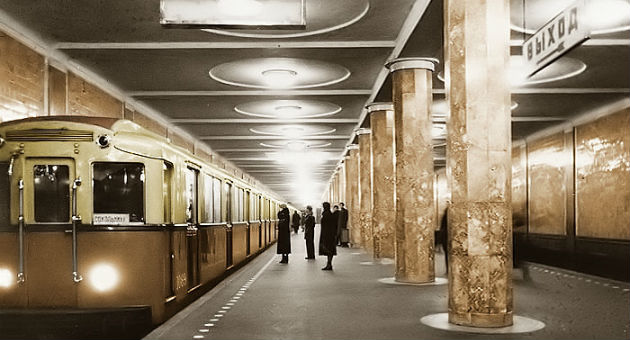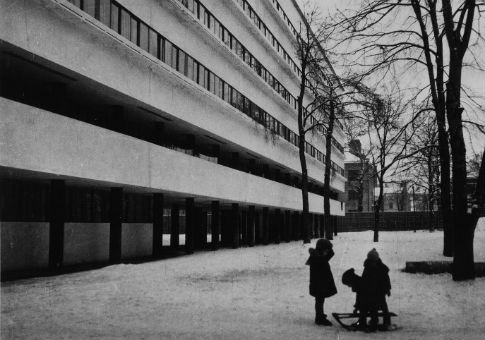"We are not against beauty, but we are against superfluity," Soviet Premier Nikita Khrushchev said in a 1954 speech that marked a turning point in Soviet architecture. Stalinist architects, he said, should be ashamed of their focus on individualization and decoration over standardization and pragmatism. "Certain architects have a passion for adding spires to the tops of buildings, which gives this architecture an ecclesiastical appearance. Do you like the silhouette of churches?"
The speech was given at the outset of Khrushchev’s mass housing project, which promised private housing to Soviet families who had previously been forced to share overcrowded apartments called kommunalki. His plan rejected Lenin’s kommunalka and Stalin’s baroque Potemkin architecture, prioritizing utility and quantity over form. The average Soviet citizen, he proclaimed, did not need his city adorned with decadent Doric columns, and he certainly did not need his home filled with frilly furniture. He simply needed his own place to eat, sleep, and work, for these were the central activities of the Soviet citizen. Thus the khrushchevka, designed for the people, not for the legacy of the architect, came into being.
Khrushchevki were practical, mass-produced, monstrous concrete complexes, constructed to incubate productive citizens. As such, they reflected the way of life of the Soviet citizen under the communist regime. Soviet architecture, like Soviet literature or fine art, said and says something about "the spirit" or culture of the Soviet political regime just as architecture in ancient Greece said and says something about Athenian democracy.

In his book Landscapes of Communism, Owen Hatherley attempts to understand the USSR by examining "distinctive" spaces across the Soviet bloc—spaces, he argues, that could not occur in a "profit-driven society." In each chapter Hatherley profiles a different feature of communist architecture: boulevards, mass apartments, the Moscow metro. He considers the "zigzags of official style" under the Soviet Union and persuasively refutes the common notion that Soviet architecture is monolithically Modernist.
Hatherley’s other goal—to examine the many faces of architecture in the USSR and discover "something new about the vanished society it housed"—remains unfulfilled. On his voyage through the former Soviet bloc, Hatherley seeks to promote an idealized vision of socialism, which hinders any effort to understand the effect of communist buildings on the souls of the citizens who lived in them. His devotion to the cause of "real socialism" leads him to think in terms of social and economic factors, rather than moral or spiritual ones. Rather than considering the loneliness that could result from living in a poorly-made khrushchevka, he sees these apartments as astounding economic achievements, much like Khrushchev did.
Hatherley favors breadth over depth, examining dozens of sites at a superficial level, describing their appearance and architectural ancestry. Each chapter is filled with lengthy physical descriptions and tangents—for example, personal vendettas against individuals on both the left and the right: Thomas Friedman is a "buffonish imperial pundit" and P. J. O’Rourke is a "right-wing hack." The book reads like entries from a nostalgic travel diary woven in with an apologia for totalitarianism.

Hatherley does worry that "it is difficult not to worry that you’re going to sound like an apologist" when writing six hundred pages about communist architecture. To his credit, he consistently points out the hypocrisy of the USSR, especially under Stalin, where grandiose buildings were built mainly for bureaucrats in a so-called pro-worker regime. "There is very little that is egalitarian or democratic about these structures," Hatherley writes of the ‘Moscow Seven’—ornate skyscrapers in a Baroque-Gothic style that serve as "the most obvious … legacy of Stalin’s despotism."
Hatherley also brings two interesting aspects of communist architecture to light that will likely be news to non-experts. The first is that it was not monolithic. While architecture from the USSR is typically associated with Khrushchev’s grey apartment complexes, the Soviet leader’s pragmatic style was a reaction to the decadent Stalinist style that came before. The result is a sort of confused lurching from one extreme to the other—from the minimal khrushchevki to the excessive ornamentation of Stalinism and the Moscow Metro. Hatherley also shows the reader that public spaces turned out to be the most individualized, ornate spaces in the Soviet Union because they were meant for public consumption and, therefore, could not be commoditized.
Still, it is difficult to ignore the effect that Hatherley’s devotion to socialism has on his analysis. For example, he idealizes "social condensers": buildings that placed apartments, libraries, factories, and cafeterias under one roof to enforce collectivist living. They were "great spaces of non-standardization," "designed to install a specifically communal way of life and thinking." Social condensers, he continues, were meant to transcend "places of assembly" in bourgeoisie society such as "the theatre and the church," which, for Hatherley, seem indistinguishable. Without a note of judgment he writes that churches were transformed into "modern buildings for communist self-education," and that the Soviet regime replaced "collective religious experience" with something "equally fulfilling," without all those pesky "aesthetic and spiritual props" of religious rituals.
In the chapter on social condensers, he profiles an odd-looking Worker’s Club in Moscow, which features "three cantilevered volumes, giant polygons punching the air" separated by "strips of plate glass," all "erupt[ing] from a triangular site, thrusting outwards from a point, which can only be found round the back." When he attempted to enter the building, Hatherley found that it was "closed for renovation"—which is Russian for abandoned.

It is rather unsurprising that such an unsightly building, like many of the other buildings featured, is not being used for anything constructive. Still, Hatherley is blind to the limitations of its charms, and laments that it is "being treated so carelessly." Perhaps contemporary Russians do not use this building because, as the British philosopher Roger Scruton put it when describing an abandoned office in England, "this building is boarded up because nobody has a use for it, nobody has a use for it because nobody wants to be in it, nobody wants to be in it because the thing is so damn ugly."
The Worker’s Club is ugly because the regime under which it was created, for which it was created, was ugly. It is difficult to detach the external appearance of these buildings—whether well or poorly designed—from the effect they were meant to have on the citizens for whom they were built. Worker’s Clubs were often built in abandoned churches to symbolize the messianism of the Soviet regime, which replaced all that came before it with "a new social order, a new set of economic arrangements, a new political entity, a new kind of human being." Communism sought to immanentize salvation. Why wait until the afterlife when man could bring about fulfillment in this life with his own two hands?
Accordingly, Soviet architecture—whether as an egalitarian, functional rejection of classical forms or as a grandoise and clunky facsimile of them—used modern materials to reflect man’s ability to subdue nature. Architecture in the USSR was a monument to man akin to the Tower of Babel, whereas classical or bourgeois architecture was often a tribute to some principle or power conceived of as higher than man. Soviet designs were also a self-aware attempt to impose certain patterns of behavior, as opposed to fitting architecture to the patterns that people actually want to live.
Regrettably, the majority of Landscapes of Communism is a quest to discover the good of socialism in the ruins of the Soviet bloc rather than a consideration of the relationship between a regime’s bleak architecture and the correspondingly bleak character of the regime itself. Hatherly will not be discouraged, however. He hypothesizes that perhaps, with enough work and the right conditions, "the socialist city, communally owned, democratically run, consciously created, made by its inhabitants" will come about one day.
"It remains for the future to build it," he writes.
